SEO
How to Find Your Competitors’ Backlinks (And Get Them for Yourself)

If you’re looking to build more backlinks to your website, checking how your competitors built and earned their backlinks is a good starting point.
That’s because understanding how they got links can help inform your link building strategy.
In this post, you’ll learn how to find, replicate, and learn from your competitors’ backlinks.
You need an SEO tool like Ahrefs to do this, which is consistently voted top dog in SEO industry polls.
Free method (top 100 backlinks)
Head over to our free backlink checker and plug in your competitor’s domain or URL. You’ll see the total number of backlinks and referring domains (linking websites) and the top 100 backlinks (referring page, anchor, and target URL).
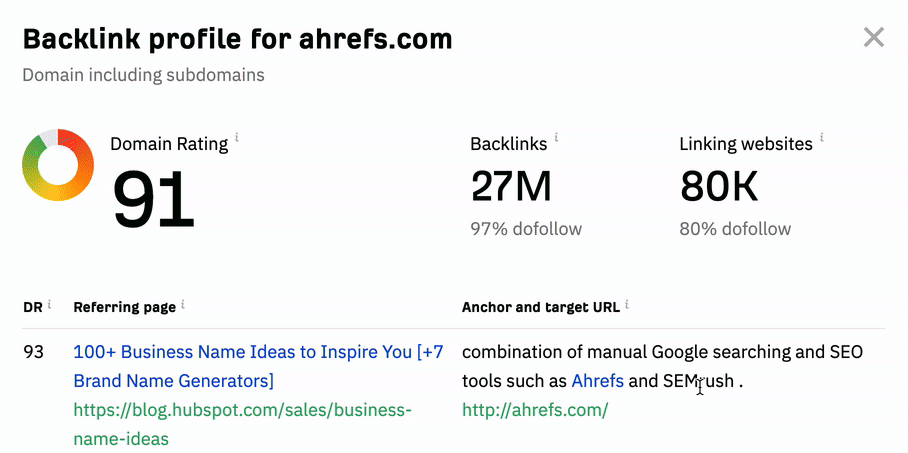
Paid method (all backlinks)
Sign up for Ahrefs, plug your competitor’s domain or URL into Site Explorer, then go to the Backlinks report. You’ll see all their backlinks. In this case, over 80,000 of them.

If you want to hone in on specific backlinks, such as those from English pages on websites with traffic, use the filters.

Not sure who your competitors are?
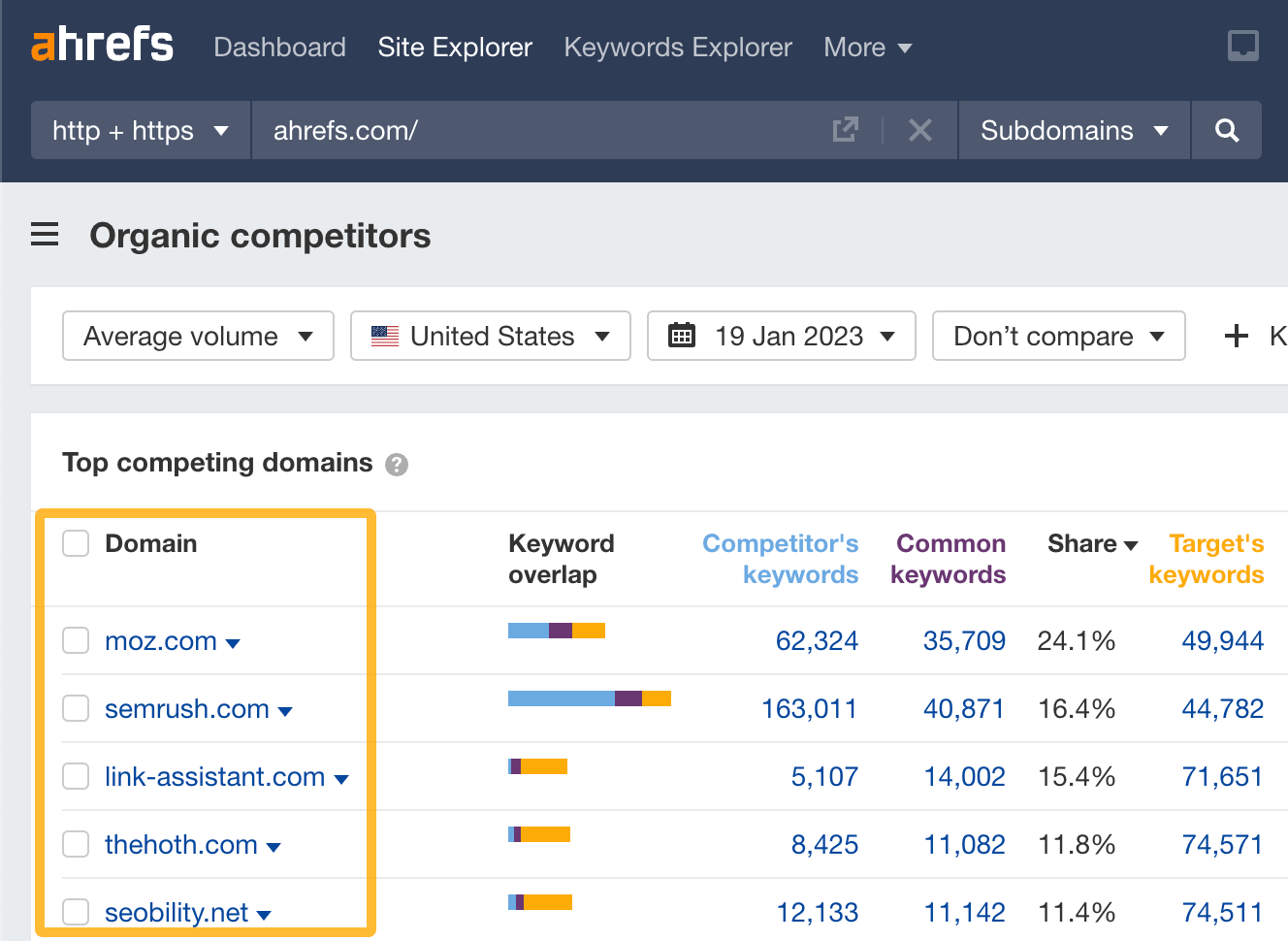
It’s impossible to replicate all of your competitors’ backlinks, but there are ways to get some of them (or similar ones) for yourself:
- Find and copy their replicable links
- Find and copy the link building tactics that are working for them
- Find links that you can loot from them
Let’s take a closer look at how to do these three things.
Finding your competitors’ replicable links
Most of your competitors’ backlinks will be extremely hard to replicate like for like, but it’s usually possible to replicate some of them. Let’s look at a few ways to do this.
Find competitors’ directory links
Directory links are far from the most powerful links, but they’re easy to replicate. Many SEOs believe they help with “map pack” rankings for local businesses too.
Here’s the easiest way to find them:
- Enter your homepage into Site Explorer
- Go to the Link Intersect report
- Enter a few competitors’ homepages in blank fields
- Set the search mode for all pages to “URL”
- Hit “Show link opportunities”
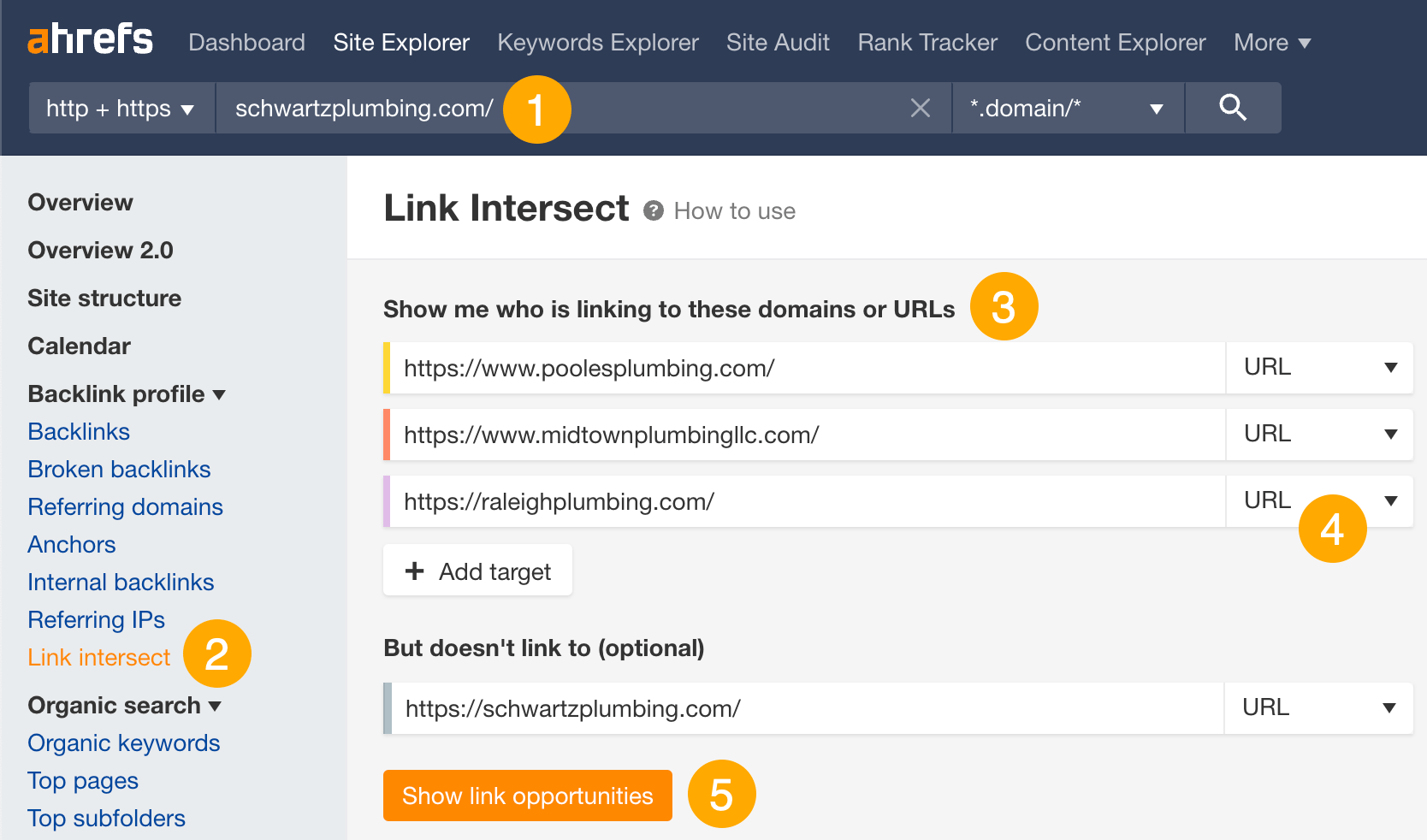
This will show you the websites linking to one or more of your competitors’ homepages, but not to yours. It’s then just a case of eyeballing the list for sites that look like niche and local directories.
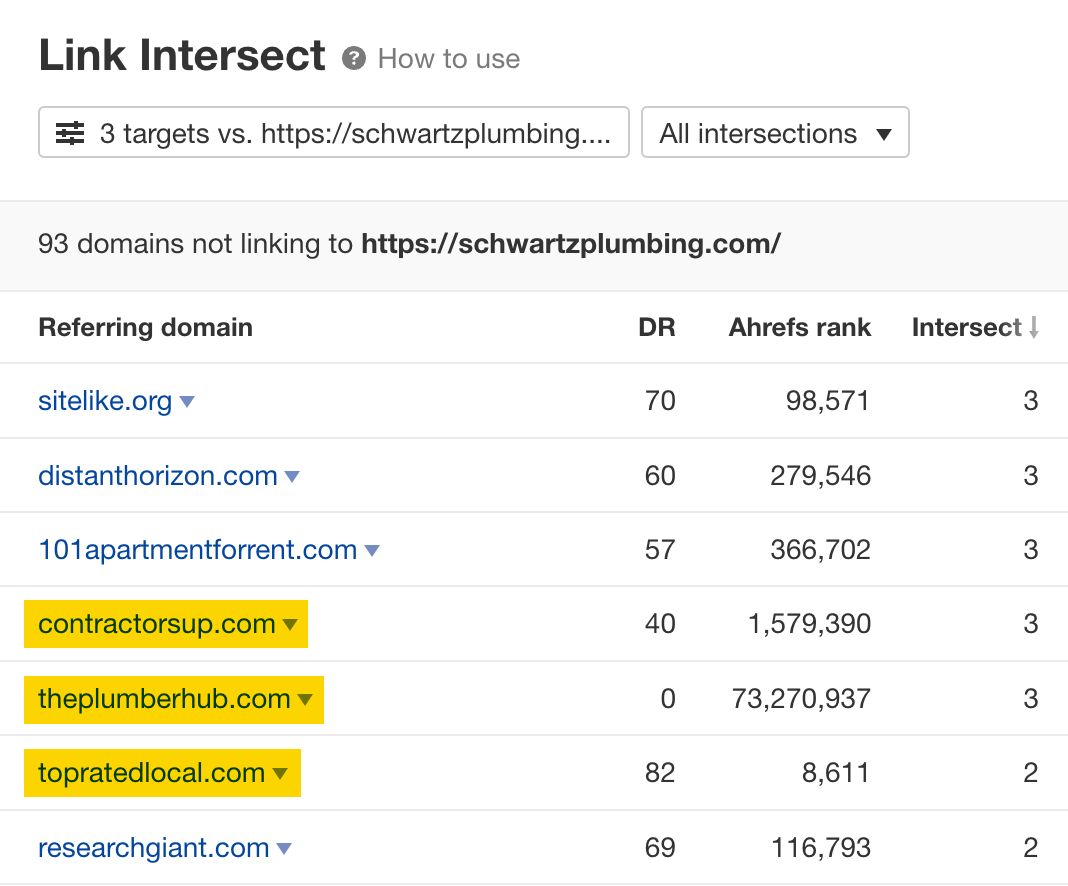
If you’re not sure whether a site is a directory, click the caret in one of the competing page columns to see the referring page, anchor, and backlink. You can usually tell from this.

If you’re still unsure, click on the page to check manually.

Replicating these links is usually as simple as signing up for an account and adding your business.
Sidenote.
Be aware that some directories charge a fee. Don’t be tempted to pay these for SEO purposes, as they won’t be worth it. Only pay if the directory is likely to send you customers.
Find listicles where competitors are mentioned, but not you
If competitors are mentioned in listicles of the best tools/restaurants/whatever your business does, there’s a chance you may be able to get mentioned in that same listicle (and a mention usually comes with a link).
These kinds of listicles are usually easy to spot in a competitor’s Backlinks report.
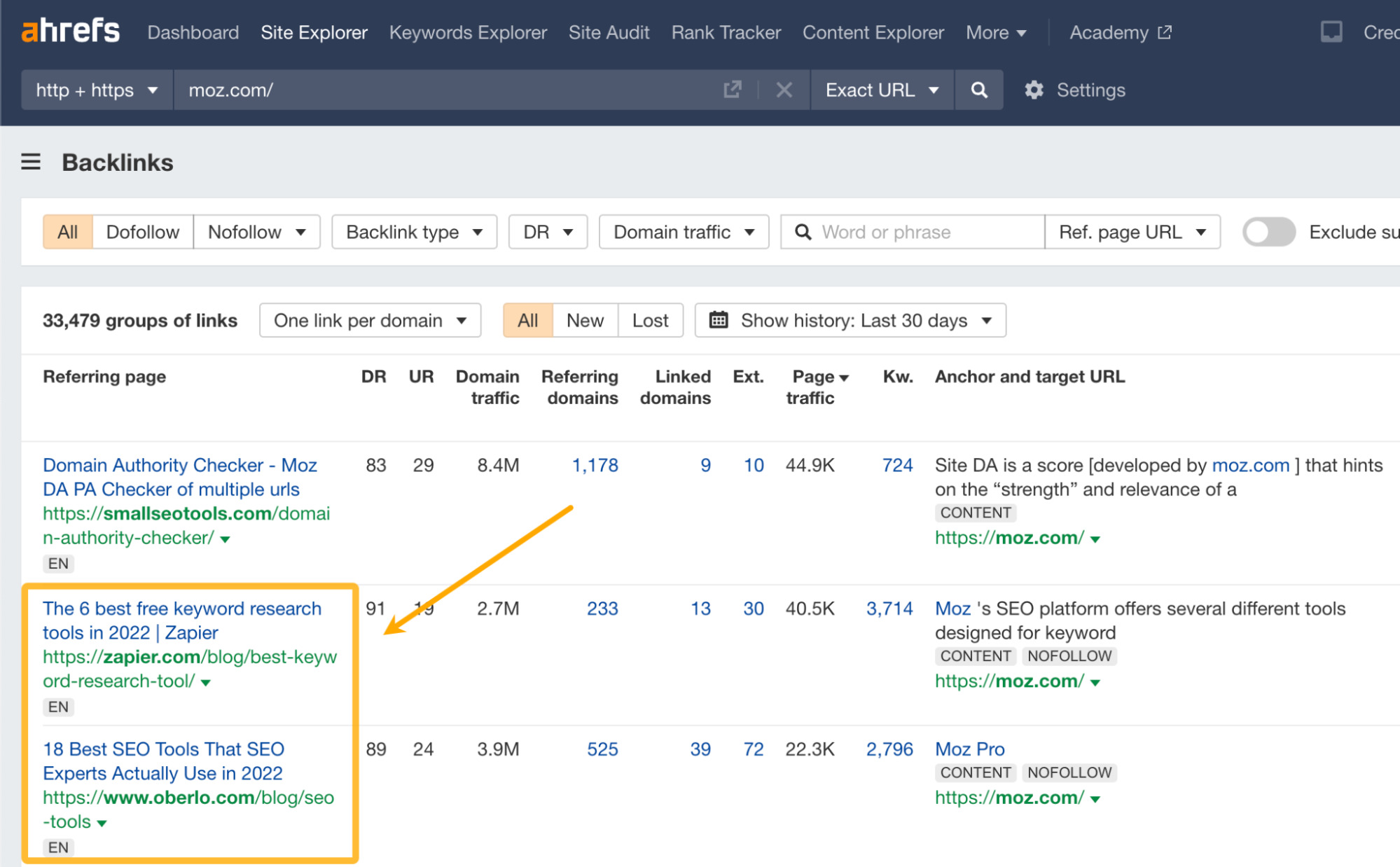
However, the best opportunities come from listicles mentioning multiple competitors because the topic of the page is more likely to be relevant to your business.
Here’s an easy way to find these:
- Go to Ahrefs’ Content Explorer
- Search for “competitor 1” “competitor 2” “competitor 3” -“your business name”

Sidenote.
Using this method, there’s no guarantee that the mentions are linked, but they usually are.
It’s then just a case of sifting through the results and pitching the authors of listicles where it makes sense to add your business.
Here’s what that pitch might look like for Aweber:
Hey [Name],
Just came across your list of the best email marketing tools and noticed Aweber wasn’t included. Is that because you didn’t like our platform or haven’t tried it?
If it’s the latter, I’d love to hook you up with a free account so you can give it a shot.
What do you think?
[Name]
Note that the email doesn’t explicitly ask the author to add anything to their list. It just asks if they’re familiar with the sender’s tool. This is intentional. It’s easier to ask for inclusion after you win folks over.
Find competitors’ links from interviews and podcasts
Interview and podcast links are more common in some industries than others, so you may not find any among your competitors. But as they only take a minute to search for, it’s well worth a quick check.
Here’s an easy way to find them:
- Go to Site Explorer
- Enter the Twitter profile URL of your competitor’s CEO, CMO, or whoever the most prolific marketer is within the company
- Go to the Backlinks report
- Filter for results where the referring page URL contains “podcast,” “episode,” or “interview”

You then just need to pitch the same interviews and podcasts.
Find competitors’ guest posts
Guest posting is the third most popular link building tactic, according to Aira’s 2022 State of Link Building report, so it’s probably a tactic that at least some of your competitors are using.
However, while you can find them in a competitor’s Backlinks report, they can be hard to spot.
For example, one of the links below is from a guest post and the other isn’t. But there’s no way to tell this from the link profile itself.

With that in mind, here’s an easier way to find a competitor’s guest posts:
- Go to Content Explorer
- Search for topic + author:“name of your competitor’s prolific marketer”
- Filter for one page per domain
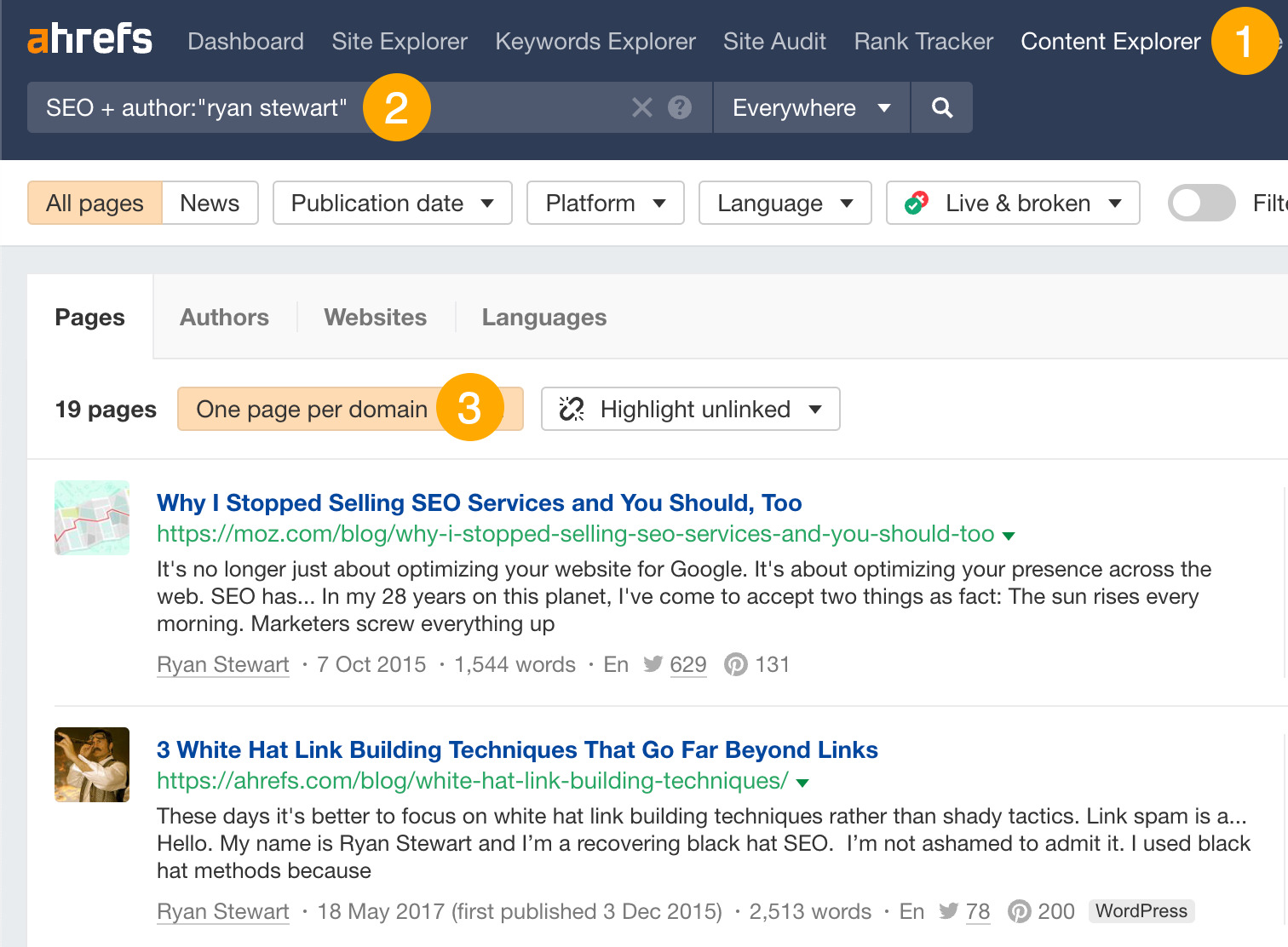
Most of the results should be guest posts by that person. Replicating them is as simple as reaching out and pitching the same websites.
Finding and copying link building tactics that work for competitors
If your competitors have lots of backlinks from directories, podcasts, interviews, or guest posts, these link building tactics are clearly working for them. So don’t limit yourself to replicating only the exact links they got. Pursue other links from these tactics too.
Here are some tutorials to help:
Sidenote.
*Most citations come from directories, so building citation opportunities is pretty much the same thing as finding opportunities to get links from directories.
However, there are two more commonly used tactics worth checking for.
Check for links from journalist requests
Bloggers and journalists often use services like Help A Reporter Out (HARO) and MuckRack to source quotes for upcoming stories—and they usually link to their sources.
For example, here’s someone from “Martha Stewart Living” asking for a quote about how plumbing leaks occur in the home.

Max Rose from Four Seasons Plumbing was one of the people to respond to this, and he received a quote and backlink from the article in return.

Here’s how to check if your competitors are building backlinks this way:
- Go to Site Explorer
- Enter a competitor’s homepage
- Set the search mode to “Exact URL”
- Go to the Backlinks report
- Look for quotes in the “Anchor and target URL” column
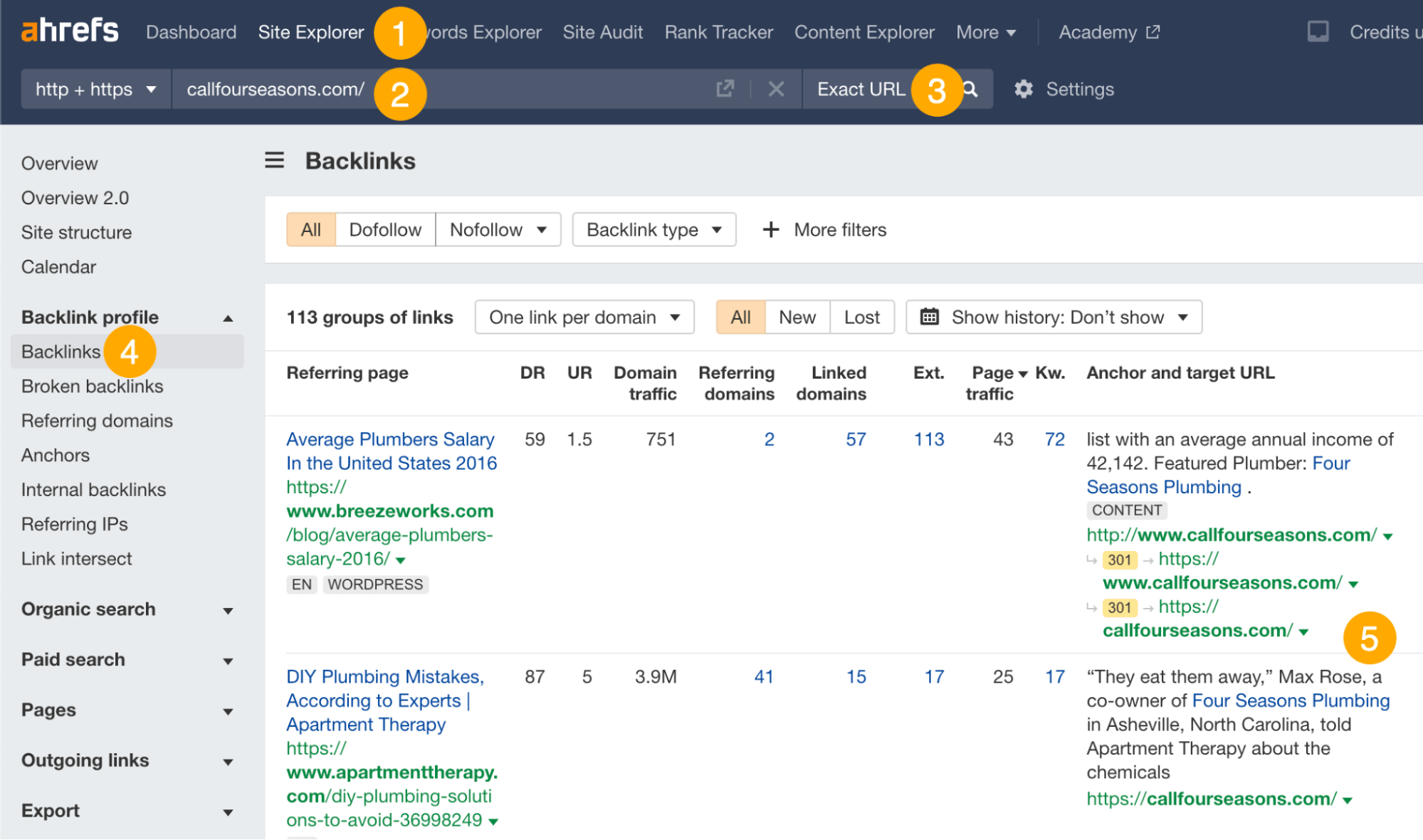
If you spot a few quotes from the same person, like “Max Rose” in this case, filter for that name in the anchor and surrounding text to hone in on these kinds of links.
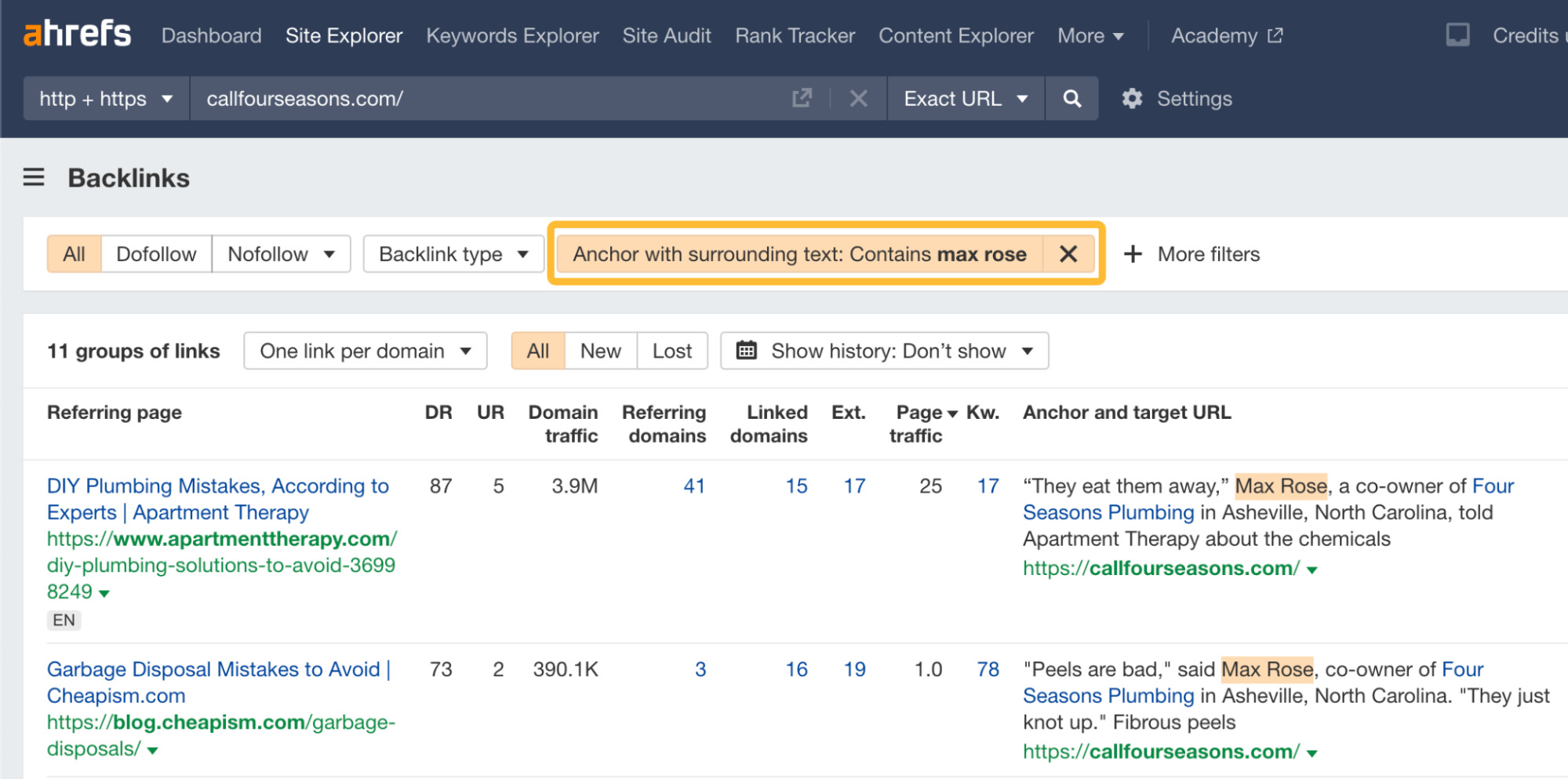
If you see a fair number of links from quotes, there’s a good chance your competitor is actively responding to journalist requests—and that it’s working. So it’s probably worth responding to requests via HARO and similar platforms yourself too.
Check for passively earned links from linkable points
Linkable points are things like facts, statistics, and unique ideas that resonate with the linkerati and attract backlinks. Even if your competitors aren’t consciously using this tactic to earn links, it could still be one of the ways they’re earning them—so it’s worth checking.
Here’s how to do that:
- Go to Site Explorer
- Enter one of the top-ranking pages for your target keyword
- Go to the Anchors report
- Look for anchors relating to facts, figures, or unique ideas
For example, the Anchors report for a page ranking for “seo copywriting” mentions the “APP” method/formula a few times:
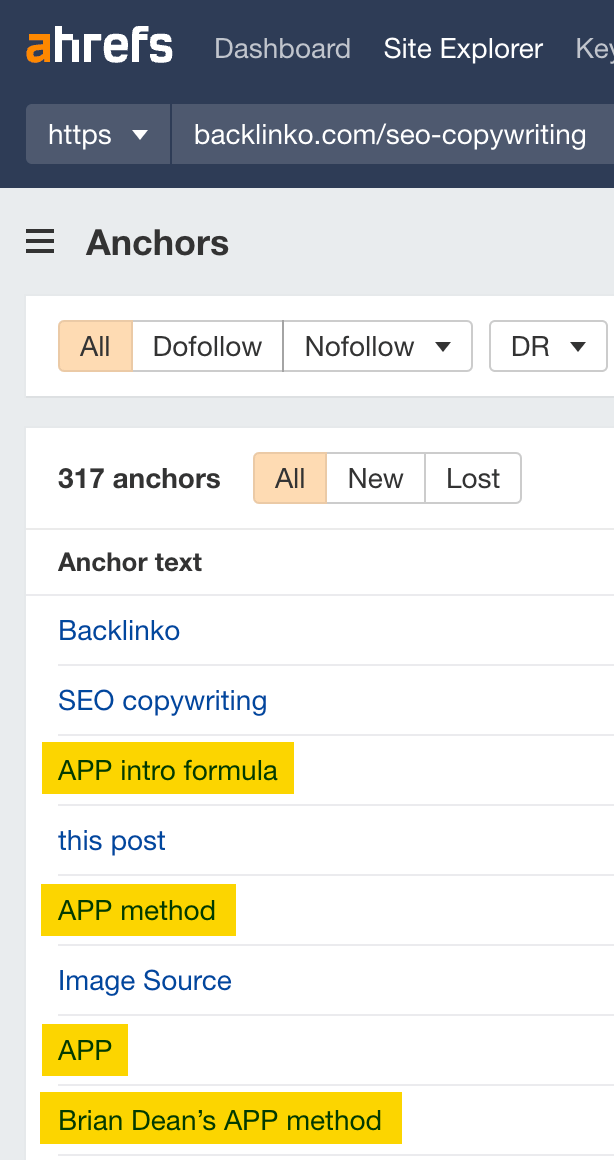
This is a term coined by the post’s author, and it has earned him some decent links.
Because of this, when we wrote our own guide to SEO copywriting, we decided to coin a similar term in an effort to earn some passive backlinks.

If we check the Anchors report for our page, we can see it’s earned us a couple of links so far:
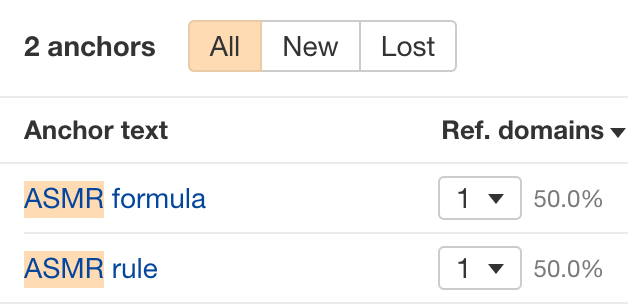
This is not astonishing by any stretch of the imagination, but they’re two links we wouldn’t have unless we included proven, linkable points.
We had more success with this method when creating our list of SEO statistics (we documented that process in this link building case study), which has earned links from over 1,700 referring domains in under two years.
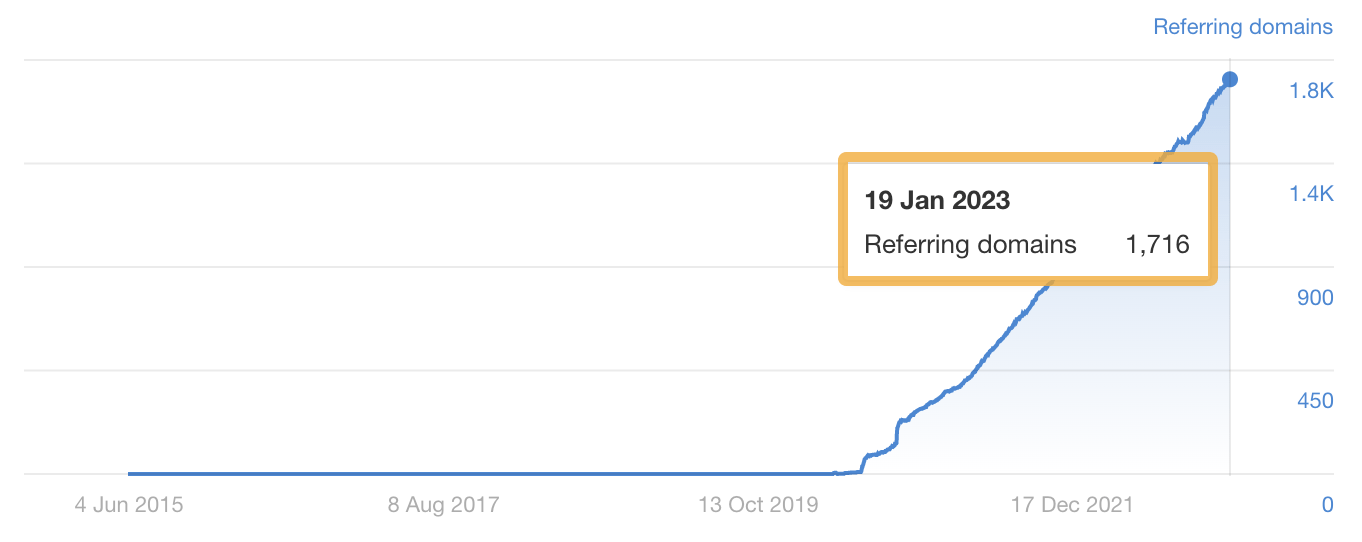
Finding links you can loot from competitors
Your competitors may have links that no longer make sense for them to have. If you can provide linkers with a better alternative, you can often take these links for yourself.
Here are a few tactics that revolve around this idea:
Broken link building
Broken link building is where you find a dead page with backlinks, create your own resource on the topic, then ask linkers to link to that instead.
For example, this page about SEO tips can’t be found:

If we plug that URL into Ahrefs’ Site Explorer, we see it has backlinks from 177 referring domains:
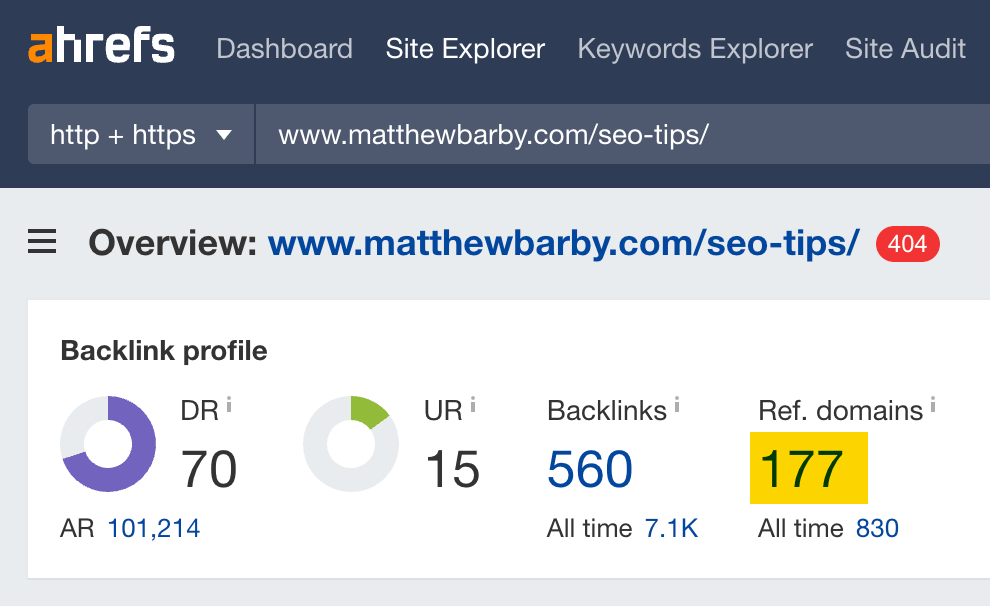
If we were to create our own list of SEO tips, we could reach out to these 177 websites and suggest replacing that dead link with a link to our list.
But how do you find your competitors’ broken pages with backlinks in the first place?
If you have a specific competitor in mind, do this:
- Go to Site Explorer
- Enter your competitor’s domain
- Go to the Best by links report
- Add a “404 not found” HTTP code filter
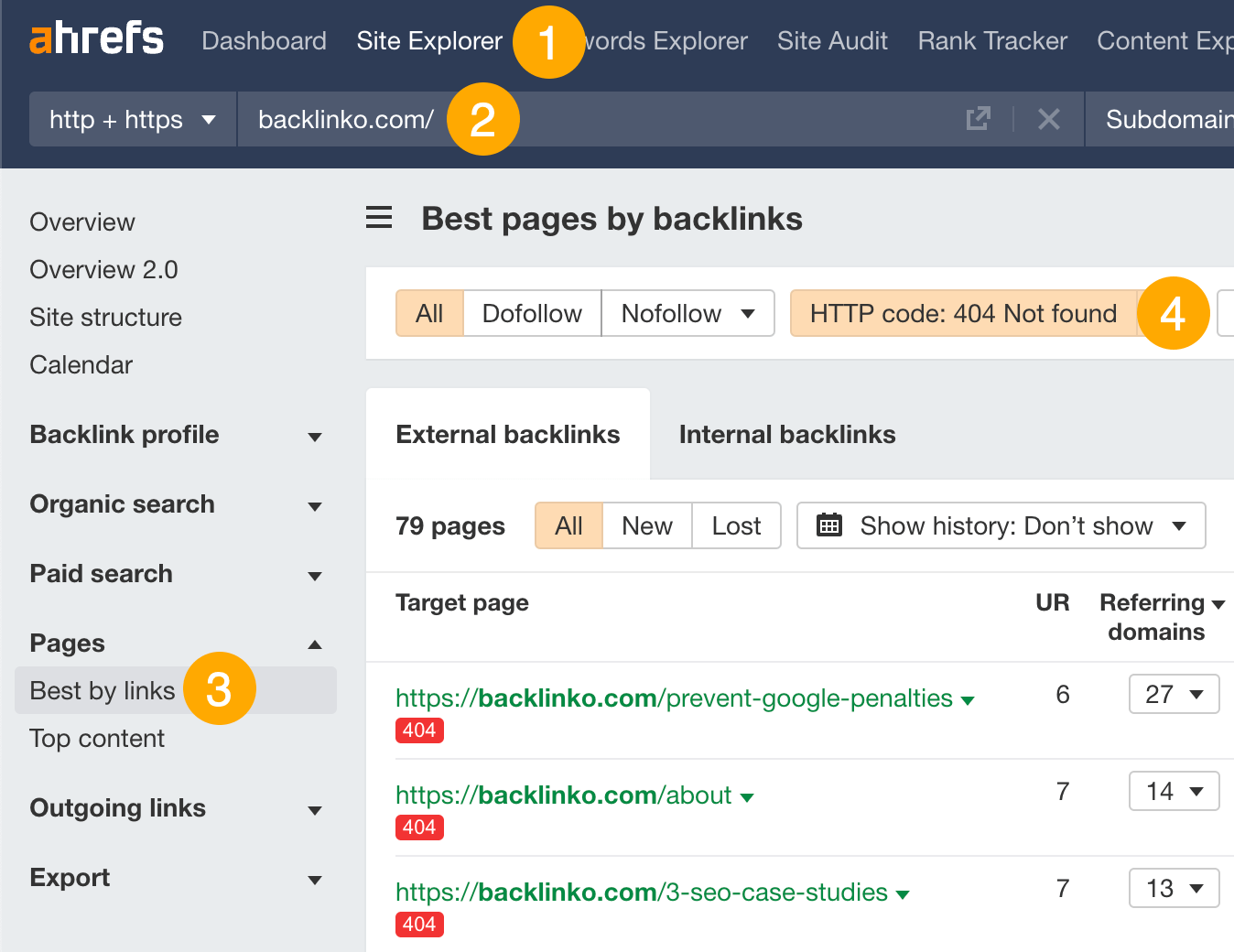
You’ll see a list of dead pages on their website, sorted by the number of referring domains pointing to them.
If you don’t have a specific competitor in mind, do this:
- Go to Ahrefs’ Content Explorer
- Search for a topic
- Filter for broken pages only
- Filter for pages with referring domains (the minimum number is up to you)
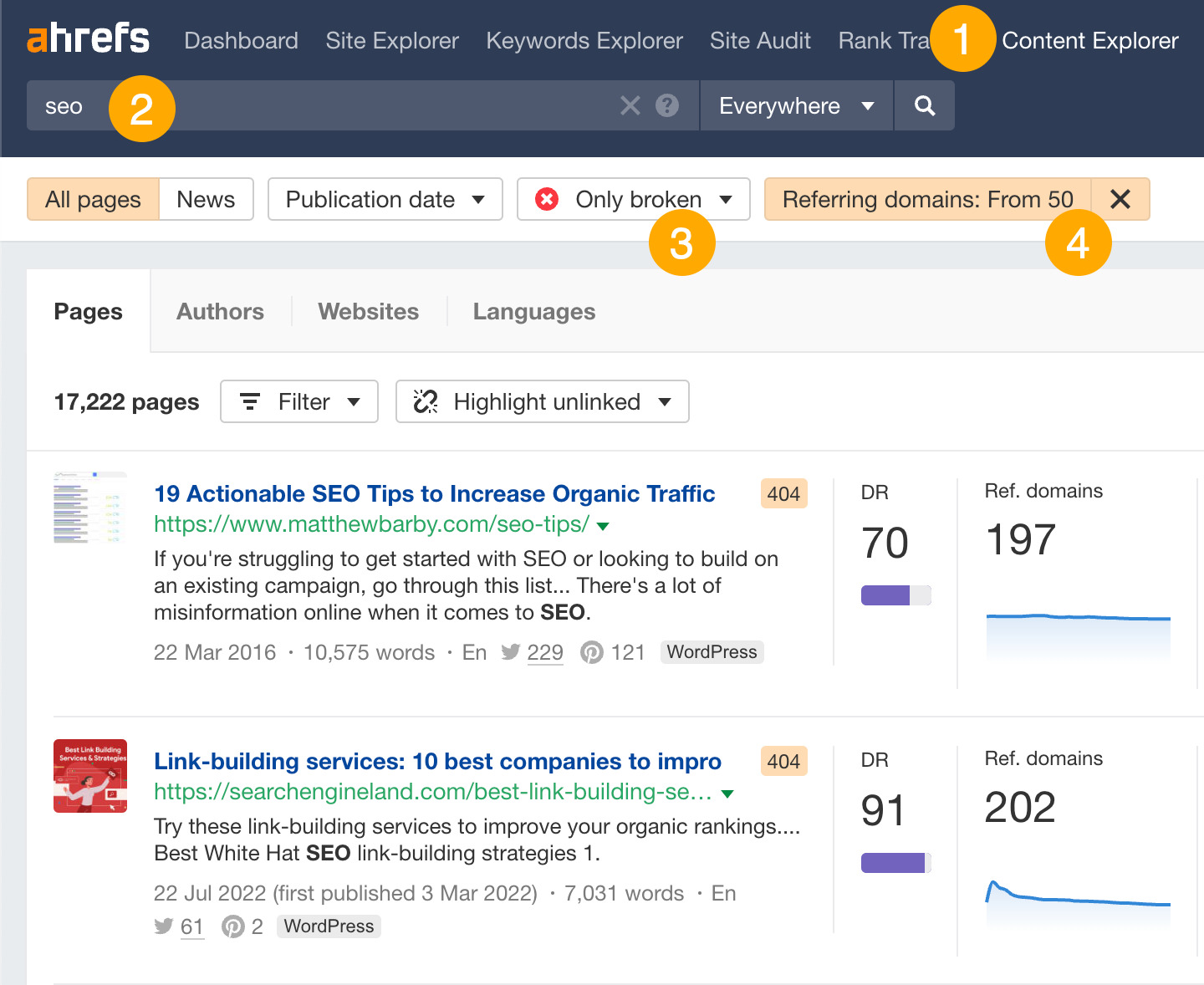
You’ll see a list of broken pages related to the topic with at least the minimum set number of referring domains.
Regardless of which method you use, the process from there is the same:
- Check what the page used to be – To do this, plug the URL into the Wayback Machine. It needs to be something you can create similar content about.
- Check the quality of the page’s backlinks – To do this, run a backlink audit in Site Explorer. If it doesn’t have good links, it’s not the best opportunity for a broken link building campaign.
- Reach out to linkers and suggest they swap the link – To do this more easily, use an outreach tool like Pitchbox or BuzzStream.
301 redirect link building
301 redirect link building is where you look for your competitors’ irrelevant redirects, then pitch a replacement to linkers.
For example, this page about the Google Penguin Update on Search Engine Land has backlinks from 1.2K referring domains:

But, for some reason, it redirects to a page about “Google SEO”:

This is a problem because people clicking through from those 1.2K websites will end up on a completely unrelated page. For that reason, there’s an opportunity here to pitch a link swap to linkers (same as with broken link building).
But how do you find your competitors’ irrelevant 301 redirects in the first place?
- Go to Site Explorer
- Enter a competitor’s domain
- Go to the Best by links report
- Add a “3XX redirect” HTTP code filter
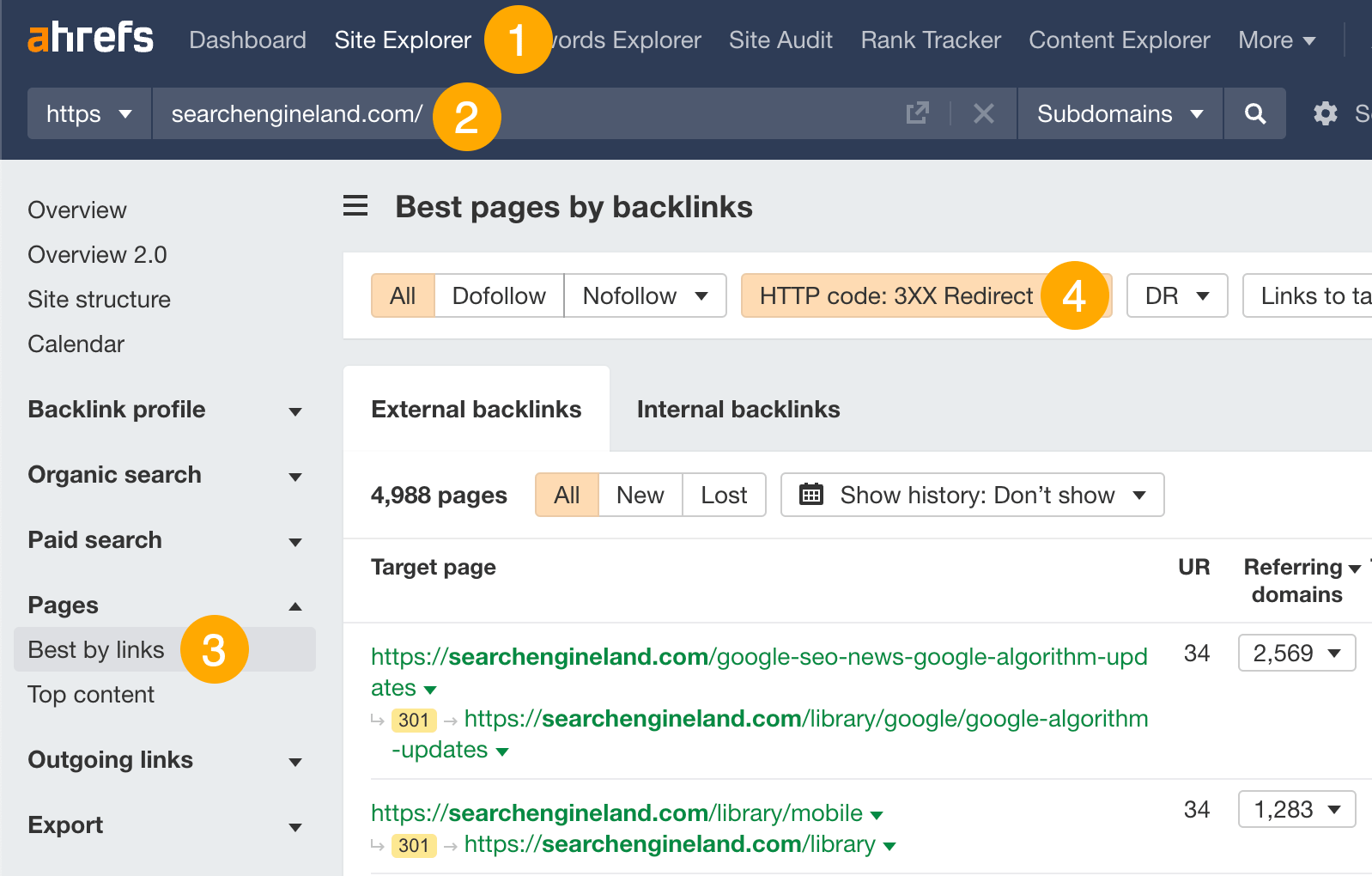
It’s then just a case of double-checking what the page used to be in the Wayback Machine, auditing the quality of the page’s links, creating a relevant replacement, and suggesting it to linkers.
Run a competitor link analysis
Some of your competitors’ “lootable” links won’t fall neatly into the box of a known link building tactic. The process of finding them is quite nuanced and takes some experience, but you’ll often find unique pitches this way.
For example, say we wanted to build links to our list of Google ranking factors. If we check the top-ranking results for this keyword in Ahrefs’ Keywords Explorer, we see that many of them have hundreds of (potentially “lootable”) backlinks from hundreds of domains:

When I plugged one of those competing URLs into Site Explorer and checked the Backlinks report, alarm bells started to ring when I saw the anchor and surrounding text for this link:

It claims that bounce rate, dwell time, and repeat visits are ranking factors.
Given that this link must be based on advice from the linked (competing) page, I decided to take a look myself. What I found was a page giving lots of dangerously bad advice:
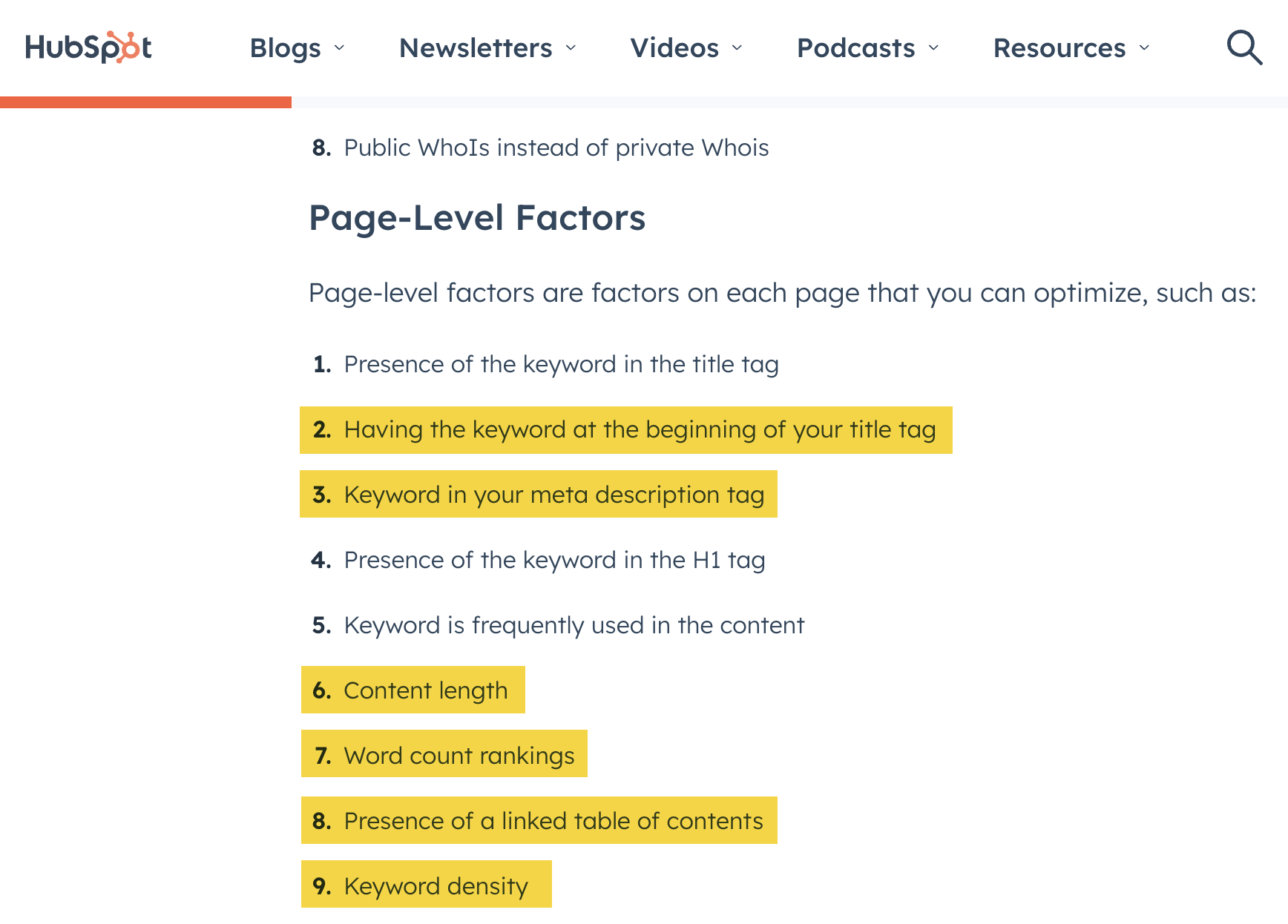
I’m not sure how much linkers would care, but I think there’s an opportunity here to reach out to all worthwhile prospects, explain that they’re linking to an inaccurate post, and suggest linking to our list of ranking factors instead.
Even if only a fraction of them care, we win a few links while combating misinformation. It’s a win-win.
Final thoughts
Finding your competitors’ backlinks is easy. Getting the same ones to your site is less easy.
But that doesn’t mean it isn’t possible. Start by replicating the easy ones, then find and copy the link building tactics that work for them, and finally take any links they no longer deserve for yourself.
Got questions? Ping me on Twitter.
SEO
How To Write ChatGPT Prompts To Get The Best Results

ChatGPT is a game changer in the field of SEO. This powerful language model can generate human-like content, making it an invaluable tool for SEO professionals.
However, the prompts you provide largely determine the quality of the output.
To unlock the full potential of ChatGPT and create content that resonates with your audience and search engines, writing effective prompts is crucial.
In this comprehensive guide, we’ll explore the art of writing prompts for ChatGPT, covering everything from basic techniques to advanced strategies for layering prompts and generating high-quality, SEO-friendly content.
Writing Prompts For ChatGPT
What Is A ChatGPT Prompt?
A ChatGPT prompt is an instruction or discussion topic a user provides for the ChatGPT AI model to respond to.
The prompt can be a question, statement, or any other stimulus to spark creativity, reflection, or engagement.
Users can use the prompt to generate ideas, share their thoughts, or start a conversation.
ChatGPT prompts are designed to be open-ended and can be customized based on the user’s preferences and interests.
How To Write Prompts For ChatGPT
Start by giving ChatGPT a writing prompt, such as, “Write a short story about a person who discovers they have a superpower.”
ChatGPT will then generate a response based on your prompt. Depending on the prompt’s complexity and the level of detail you requested, the answer may be a few sentences or several paragraphs long.
Use the ChatGPT-generated response as a starting point for your writing. You can take the ideas and concepts presented in the answer and expand upon them, adding your own unique spin to the story.
If you want to generate additional ideas, try asking ChatGPT follow-up questions related to your original prompt.
For example, you could ask, “What challenges might the person face in exploring their newfound superpower?” Or, “How might the person’s relationships with others be affected by their superpower?”
Remember that ChatGPT’s answers are generated by artificial intelligence and may not always be perfect or exactly what you want.
However, they can still be a great source of inspiration and help you start writing.
Must-Have GPTs Assistant
I recommend installing the WebBrowser Assistant created by the OpenAI Team. This tool allows you to add relevant Bing results to your ChatGPT prompts.
This assistant adds the first web results to your ChatGPT prompts for more accurate and up-to-date conversations.
It is very easy to install in only two clicks. (Click on Start Chat.)
For example, if I ask, “Who is Vincent Terrasi?,” ChatGPT has no answer.
With WebBrower Assistant, the assistant creates a new prompt with the first Bing results, and now ChatGPT knows who Vincent Terrasi is.
 Screenshot from ChatGPT, March 2023
Screenshot from ChatGPT, March 2023You can test other GPT assistants available in the GPTs search engine if you want to use Google results.
Master Reverse Prompt Engineering
ChatGPT can be an excellent tool for reverse engineering prompts because it generates natural and engaging responses to any given input.
By analyzing the prompts generated by ChatGPT, it is possible to gain insight into the model’s underlying thought processes and decision-making strategies.
One key benefit of using ChatGPT to reverse engineer prompts is that the model is highly transparent in its decision-making.
This means that the reasoning and logic behind each response can be traced, making it easier to understand how the model arrives at its conclusions.
Once you’ve done this a few times for different types of content, you’ll gain insight into crafting more effective prompts.
Prepare Your ChatGPT For Generating Prompts
First, activate the reverse prompt engineering.
- Type the following prompt: “Enable Reverse Prompt Engineering? By Reverse Prompt Engineering I mean creating a prompt from a given text.”
 Screenshot from ChatGPT, March 2023
Screenshot from ChatGPT, March 2023ChatGPT is now ready to generate your prompt. You can test the product description in a new chatbot session and evaluate the generated prompt.
- Type: “Create a very technical reverse prompt engineering template for a product description about iPhone 11.”
 Screenshot from ChatGPT, March 2023
Screenshot from ChatGPT, March 2023The result is amazing. You can test with a full text that you want to reproduce. Here is an example of a prompt for selling a Kindle on Amazon.
- Type: “Reverse Prompt engineer the following {product), capture the writing style and the length of the text :
product =”
 Screenshot from ChatGPT, March 2023
Screenshot from ChatGPT, March 2023I tested it on an SEJ blog post. Enjoy the analysis – it is excellent.
- Type: “Reverse Prompt engineer the following {text}, capture the tone and writing style of the {text} to include in the prompt :
text = all text coming from https://www.searchenginejournal.com/google-bard-training-data/478941/”
 Screenshot from ChatGPT, March 2023
Screenshot from ChatGPT, March 2023But be careful not to use ChatGPT to generate your texts. It is just a personal assistant.
Go Deeper
Prompts and examples for SEO:
- Keyword research and content ideas prompt: “Provide a list of 20 long-tail keyword ideas related to ‘local SEO strategies’ along with brief content topic descriptions for each keyword.”
- Optimizing content for featured snippets prompt: “Write a 40-50 word paragraph optimized for the query ‘what is the featured snippet in Google search’ that could potentially earn the featured snippet.”
- Creating meta descriptions prompt: “Draft a compelling meta description for the following blog post title: ’10 Technical SEO Factors You Can’t Ignore in 2024′.”
Important Considerations:
- Always Fact-Check: While ChatGPT can be a helpful tool, it’s crucial to remember that it may generate inaccurate or fabricated information. Always verify any facts, statistics, or quotes generated by ChatGPT before incorporating them into your content.
- Maintain Control and Creativity: Use ChatGPT as a tool to assist your writing, not replace it. Don’t rely on it to do your thinking or create content from scratch. Your unique perspective and creativity are essential for producing high-quality, engaging content.
- Iteration is Key: Refine and revise the outputs generated by ChatGPT to ensure they align with your voice, style, and intended message.
Additional Prompts for Rewording and SEO:
– Rewrite this sentence to be more concise and impactful.
– Suggest alternative phrasing for this section to improve clarity.
– Identify opportunities to incorporate relevant internal and external links.
– Analyze the keyword density and suggest improvements for better SEO.
Remember, while ChatGPT can be a valuable tool, it’s essential to use it responsibly and maintain control over your content creation process.
Experiment And Refine Your Prompting Techniques
Writing effective prompts for ChatGPT is an essential skill for any SEO professional who wants to harness the power of AI-generated content.
Hopefully, the insights and examples shared in this article can inspire you and help guide you to crafting stronger prompts that yield high-quality content.
Remember to experiment with layering prompts, iterating on the output, and continually refining your prompting techniques.
This will help you stay ahead of the curve in the ever-changing world of SEO.
More resources:
Featured Image: Tapati Rinchumrus/Shutterstock
SEO
Measuring Content Impact Across The Customer Journey

Understanding the impact of your content at every touchpoint of the customer journey is essential – but that’s easier said than done. From attracting potential leads to nurturing them into loyal customers, there are many touchpoints to look into.
So how do you identify and take advantage of these opportunities for growth?
Watch this on-demand webinar and learn a comprehensive approach for measuring the value of your content initiatives, so you can optimize resource allocation for maximum impact.
You’ll learn:
- Fresh methods for measuring your content’s impact.
- Fascinating insights using first-touch attribution, and how it differs from the usual last-touch perspective.
- Ways to persuade decision-makers to invest in more content by showcasing its value convincingly.
With Bill Franklin and Oliver Tani of DAC Group, we unravel the nuances of attribution modeling, emphasizing the significance of layering first-touch and last-touch attribution within your measurement strategy.
Check out these insights to help you craft compelling content tailored to each stage, using an approach rooted in first-hand experience to ensure your content resonates.
Whether you’re a seasoned marketer or new to content measurement, this webinar promises valuable insights and actionable tactics to elevate your SEO game and optimize your content initiatives for success.
View the slides below or check out the full webinar for all the details.
SEO
How to Find and Use Competitor Keywords

Competitor keywords are the keywords your rivals rank for in Google’s search results. They may rank organically or pay for Google Ads to rank in the paid results.
Knowing your competitors’ keywords is the easiest form of keyword research. If your competitors rank for or target particular keywords, it might be worth it for you to target them, too.
There is no way to see your competitors’ keywords without a tool like Ahrefs, which has a database of keywords and the sites that rank for them. As far as we know, Ahrefs has the biggest database of these keywords.
How to find all the keywords your competitor ranks for
- Go to Ahrefs’ Site Explorer
- Enter your competitor’s domain
- Go to the Organic keywords report
The report is sorted by traffic to show you the keywords sending your competitor the most visits. For example, Mailchimp gets most of its organic traffic from the keyword “mailchimp.”


Since you’re unlikely to rank for your competitor’s brand, you might want to exclude branded keywords from the report. You can do this by adding a Keyword > Doesn’t contain filter. In this example, we’ll filter out keywords containing “mailchimp” or any potential misspellings:


If you’re a new brand competing with one that’s established, you might also want to look for popular low-difficulty keywords. You can do this by setting the Volume filter to a minimum of 500 and the KD filter to a maximum of 10.


How to find keywords your competitor ranks for, but you don’t
- Go to Competitive Analysis
- Enter your domain in the This target doesn’t rank for section
- Enter your competitor’s domain in the But these competitors do section


Hit “Show keyword opportunities,” and you’ll see all the keywords your competitor ranks for, but you don’t.


You can also add a Volume and KD filter to find popular, low-difficulty keywords in this report.


How to find keywords multiple competitors rank for, but you don’t
- Go to Competitive Analysis
- Enter your domain in the This target doesn’t rank for section
- Enter the domains of multiple competitors in the But these competitors do section


You’ll see all the keywords that at least one of these competitors ranks for, but you don’t.


You can also narrow the list down to keywords that all competitors rank for. Click on the Competitors’ positions filter and choose All 3 competitors:


- Go to Ahrefs’ Site Explorer
- Enter your competitor’s domain
- Go to the Paid keywords report


This report shows you the keywords your competitors are targeting via Google Ads.
Since your competitor is paying for traffic from these keywords, it may indicate that they’re profitable for them—and could be for you, too.
You know what keywords your competitors are ranking for or bidding on. But what do you do with them? There are basically three options.
1. Create pages to target these keywords
You can only rank for keywords if you have content about them. So, the most straightforward thing you can do for competitors’ keywords you want to rank for is to create pages to target them.
However, before you do this, it’s worth clustering your competitor’s keywords by Parent Topic. This will group keywords that mean the same or similar things so you can target them all with one page.
Here’s how to do that:
- Export your competitor’s keywords, either from the Organic Keywords or Content Gap report
- Paste them into Keywords Explorer
- Click the “Clusters by Parent Topic” tab


For example, MailChimp ranks for keywords like “what is digital marketing” and “digital marketing definition.” These and many others get clustered under the Parent Topic of “digital marketing” because people searching for them are all looking for the same thing: a definition of digital marketing. You only need to create one page to potentially rank for all these keywords.


2. Optimize existing content by filling subtopics
You don’t always need to create new content to rank for competitors’ keywords. Sometimes, you can optimize the content you already have to rank for them.
How do you know which keywords you can do this for? Try this:
- Export your competitor’s keywords
- Paste them into Keywords Explorer
- Click the “Clusters by Parent Topic” tab
- Look for Parent Topics you already have content about
For example, if we analyze our competitor, we can see that seven keywords they rank for fall under the Parent Topic of “press release template.”


If we search our site, we see that we already have a page about this topic.


If we click the caret and check the keywords in the cluster, we see keywords like “press release example” and “press release format.”


To rank for the keywords in the cluster, we can probably optimize the page we already have by adding sections about the subtopics of “press release examples” and “press release format.”
3. Target these keywords with Google Ads
Paid keywords are the simplest—look through the report and see if there are any relevant keywords you might want to target, too.
For example, Mailchimp is bidding for the keyword “how to create a newsletter.”


If you’re ConvertKit, you may also want to target this keyword since it’s relevant.
If you decide to target the same keyword via Google Ads, you can hover over the magnifying glass to see the ads your competitor is using.


You can also see the landing page your competitor directs ad traffic to under the URL column.


Learn more
Check out more tutorials on how to do competitor keyword analysis:
-

 PPC5 days ago
PPC5 days ago19 Best SEO Tools in 2024 (For Every Use Case)
-

 MARKETING7 days ago
MARKETING7 days agoStreamlining Processes for Increased Efficiency and Results
-

 PPC7 days ago
PPC7 days ago97 Marvelous May Content Ideas for Blog Posts, Videos, & More
-
SEARCHENGINES7 days ago
Daily Search Forum Recap: April 17, 2024
-

 SEO7 days ago
SEO7 days agoAn In-Depth Guide And Best Practices For Mobile SEO
-
SEARCHENGINES6 days ago
Daily Search Forum Recap: April 18, 2024
-

 MARKETING6 days ago
MARKETING6 days agoEcommerce evolution: Blurring the lines between B2B and B2C
-
SEARCHENGINES4 days ago
Daily Search Forum Recap: April 19, 2024















